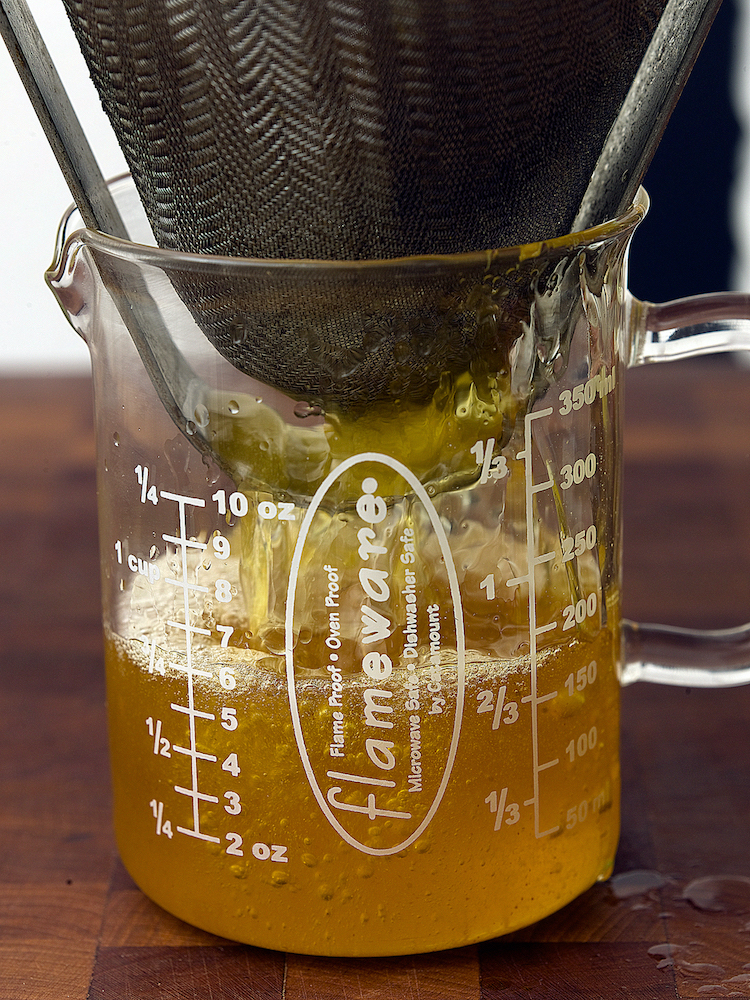

This is the stage where you need to be extra careful, as at this stage, the milk solids have sunk to the bottom of the pan and can easily begin to brown. You can tell when the clarified butter is nearly done when it stops spluttering (sign that the water has evaporated), and the bubbles become very, very small and you literally can’t hear much of anything happening anymore ( see below). The milk solids will slowly begin to sink to the bottom of the pan. It will also splutter (that is the water evaporating). Once the butter melts and begins to heat, the butter will begin to foam (I carefully skim and remove the whey that rises to the top the entire time–don’t discard it!). The goal is to remove the milk solids and allow the water content to evaporate during the heating process. So how do you make it? As I mentioned earlier, clarified butter is pure butterfat. Generally, you can expect to lose about 25% in volume once butter is clarified (1 cup of butter will yield roughly 3/4 cup clarified butter). Since clarified butter will last in the fridge for at least a month (usually, longer), I prefer to make a large batch of it at a time (i.e.

Making clarified butter is not nearly as intimidating as it sounds, but it does require low heat, patience and a watchful eye. I don’t want to know how many pounds and pounds of it I consumed. I can’t tell you how many pounds and pounds of it I made (or burned, oops) within that six-month period.
Pretty amazing, right? Hence the liquid gold reference.Ĭlarified butter became my life during culinary school. Only three other oils can boast higher smoke points than clarified butter: safflower (the highest!), rice bran (second highest), and refined olive oil (note: not extra virgin). So, what is clarified butter’s smoke point compared to other common cooking fats (such as extra virgin olive, canola, safflower, grape seed oil, etc.)? 450✯! You basically get an extra 100 degrees of cooking wiggle room.Ĭlarified butter has a higher smoke point than coconut, grapeseed, lard or duck fat, sesame, canola, and even sunflower oil! Yes, all of those! Butter also has amazing flavor. When you are cooking over high heat (sauteing, searing, stir frying, etc.), you are generally reaching temperatures in excess of 400✯. Sounds high, but that is actually one of the lowest smoke points of any cooking fat. Normal straight-from-the-fridge butter has a smoke point of 350✯ (176✬). Smoke point is a fancy way of describing the temperature that a fat can be heated to before it starts to smoke (and inevitably, burn).
/ghee-56a5107f3df78cf772862bc1.jpg)
Once you make clarified butter and remove those milk solids, butterfat has a very high smoke point. That is the result of those pesky (but delicious) milk solids. But, as I’m sure many of you have experienced, unless you are cooking it over relatively low heat, it has a tendency to burn and smoke extremely quickly. Well, there are lots of recipes and dishes that call for cooking with butter. No milk solids, no water, just pure butterfat. I’m supposed to be talking about clarified butter, right? Well, clarified butter is essentially pure butterfat. It doesn’t sound like a lot, but that small percentage of extra butterfat can make a huge difference in the baking world! The more butterfat, the greater the flavor, the less gluten will develop (tender, flaky pastries!), yada, yada, yada.īut that is an entirely different subject matter. Homemade butter can be as high as 86% butterfat. Most European butters (or European-style butter, such as Plugra, which you can find in most grocery stores now) contain at minimum 82% butterfat. In fact, butter is required to be around 80% butterfat in the states. Most generic store-bought butter is generally 80% butterfat, 16-18% water (yes, really!), and about 1-2% butter solids. To sum it up, butter consists of three things: butterfat, milk solids, and water. Or, more importantly, liquid gold in the cooking world. Clarified ButterĪre you familiar with clarified butter? I’m sure you are! A lot of people have a tendency to associate it with crab and lobster meat dunking or, sometimes, hollandaise sauce, but that doesn’t even begin to cover this stuff’s potential. And trust me, it is all good (warning: this is totally where I get nerdy when it comes to food). All types of butter! I don’t discriminate.Ĭlarified butter, ghee, and brown butter.
#Clarify butter definition how to
A comprehensive post on how to make clarified butter, ghee, and brown butter - and the difference between all three!


 0 kommentar(er)
0 kommentar(er)
